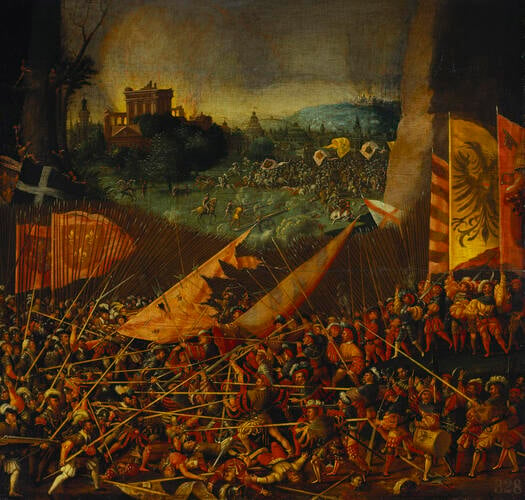The Battle of Pavia c. 1530
Oil on panel | 59.8 x 62.5 cm (support, canvas/panel/stretcher external) | RCIN 405792
-
The Battle of Pavia of 1525 was a decisive victory for the Emperor Charles V, who captured his rival, Francis I of France, on the field of battle and forced him to agree to Habsburg control of northern Italy and Burgundy. There are many depictions of this pivotal moment in the European balance of power: one by an unknown Flemish artist in the Birmingham Museum of Art; a series of Tapestries after designs by Bernard van Orley in the Museo di Capodimonte and a painting by Ruprecht Heller in the Nationalmuseum, Stockholm.
This anonymous German treatment of the subject is not the most informative for military historians. In the foreground there appears to be a schematic depiction of a decisive infantry engagement, against a backdrop of pikes, thick like a palisade and inclining inwards more and more towards the centre, where the two armies engage. The fancifully-dressed soldiers of the age make a melee of different episodes. The final outcome is implied by the neat order of the Imperial banners to the right; the two French banners being torn down to the left of centre and the fact that the French have been pushed back far into their own half. A circular aperture in the upper centre of the composition reveals a more general view of the siege of Pavia and its relief. Here we see a distant picturesque city, some individual buildings nearer to us, one in ruins and one apparently on fire. In the fields before the city there is an engagement of cavalry and cannon. The relationship between these two parts of the painting does not abbey the laws of perspective, the background is apparently framed by a rock to the right and some trees to the left, filled with soldiers chasing each other.
There was a depiction of the Battle of Pavia in the 1542 inventory of Whitehall Palace (no 804), which may have been this work or another of the same theme. This panel definitely belonged to Henry Prince of Wales: his brand appears on the back and it is listed in the 1606 inventory of his lodging at Hampton Court. It was sold from Hampton Court on 17th May 1650 to Marriot for £3. It was back at Hampton Court in 1666, described as ‘Battle between Emperor Maximilian and the French’ and measuring 1ft 9in x 2ft 10in (53 x 86cm). If these measurements are accurate the panel must have been cut, losing a quarter of its width, at some time before it is next measured - at Kensington Palace in 1818 – with its current dimensions. It was at this time that the painting appears in Pyne's illustrated Royal Residences of 1819, hanging in the Presence Chamber at Kensington Palace (RCIN 922150).
Provenance
Probably in the collection of Henry VIII; certainly in the collection of Henry, Prince of Wales, and that of his brother, Charles I, both of whose brands appear on the back of the panel
-
Creator(s)
Acquirer(s)
-
Medium and techniques
Oil on panel
Measurements
59.8 x 62.5 cm (support, canvas/panel/stretcher external)
73.7 x 75.8 x 4.0 cm (frame, external)
Category
Object type(s)
Alternative title(s)
The Battle of Pavia, 24th February 1525








